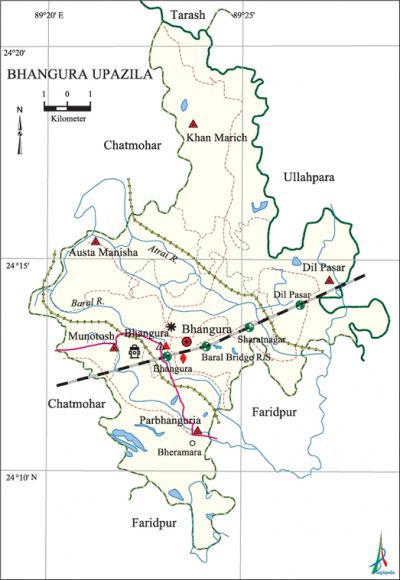Bhangura Upazila
Bhangura Upazila (pabna district) area 138.36 sq km, located in between 24°09' and 24°21' north latitudes and in between 89°20' and 89°28' east longitudes. It is bounded by tarash, chatmohar and ullahpara upazilas on the north, faridpur (Pabna) upazila on the south, Ullahpara and Faridpur upazilas on the east, Chatmohar upazila on the west.
Population Total 124433; male 61900, female 62533; Muslim 119465, Hindu 4929, Christian 17 and others 22.
Water bodies Main rivers: atrai and baral.
Administration Bhangura Thana, now an upazila, was formed in 1980.
| Upazila | ||||||||
| Municipality | Union | Mouza | Village | Population | Density (per sq km) | Literacy rate (%) | ||
| Urban | Rural | Urban | Rural | |||||
| 1 | 5 | 65 | 122 | 20606 | 103827 | 899 | 56.6 | 41.4 |
| Municipality | ||||||||
|
Area |
Ward |
Mahalla |
Population |
Density |
Literacy rate (%) | |||
| 5.13 | 9 | 37 | 20606 | 4017 | 56.6 | |||
| Union | ||||
| Name of union and GO code | Area (acre) | Population | Literacy rate (%) | |
| Male | Female | |||
| Ashta Manisha 15 | 4232 | 9127 | 8940 | 43.1 |
| Khan Marich 63 | 7440 | 13830 | 13801 | 32.1 |
| Dil Pasar 47 | 6727 | 7584 | 7847 | 40.1 |
| Parbhanguria 79 | 6300 | 8240 | 8692 | 51.3 |
| Bhangura 31 | 8222 | 12882 | 12884 | 44.1 |
Source Bangladesh Population Census 2011, Bangladesh Bureau of Statistics.

Archaeological heritage and relics Three-domed ancient Mosque (Kazipara, Chandipur).
War of Liberation During the war of liberation in 1971 a battle was fought between the freedom fighters and the Pak army and razakars near Baral Bridge in which the Pak army was defeated and many razakars surrendered to the freedom fighters with their arms and ammunitions. Bhangura upazila was liberated on 15 December 1971.
For details: see ভাঙ্গুরা উপজেলা, বাংলাদেশ মুক্তিযুদ্ধ জ্ঞানকোষ (Encyclopedia of Bangladesh War of Liberation), বাংলাদেশ এশিয়াটিক সোসাইটি, ঢাকা ২০২০, খণ্ড ৭।
Religious institutions Mosque 162, temple 29. Noted religious institutions: Bhangura Jami Mosque, Kalibari Mandir, Ashta Manisha Kali Mandir.
Literacy rate and educational institutions Average literacy 44.0%; male 46.3%, female 41.7%. Educational institutions: college 2, collegiate school 1, secondary school 11, primary school 91, satellite school 13, community school 3, madrasa 3. Noted educational institutions: Haji Jamaluddin Degree College (1970), Bhangura Women College (1998), Khan Marich Technical and Business Management College (2002), B. B School and College (1985), Bhangura Zarina-Rahim Girls' High School (1969), Hasina-Momin Girls' High School (1972), Bhangura Union Pilot Multilateral School, Sharatnagar Fazil Madrasa (1927), Haji Gayez Uddin Women's Fazil Madrasa (1985).
Newspapers and periodicals Tawhid, Sachetan, Beduin, Manjil, Zharna, Unmachan, Chetana, Palli Sahitya, Smriti Lekha, Nepather Sanglap, Nishit Pradip; defunct: Zaminder, Bijli, Sombarer Chithi, Patitar Mukti, Buli, Tachhbir, Audbudaya, Akheri Takrir.
Cultural organisations Library 2, club 73, cinema hall 2, theatre group 1, women's organisation 6.
Main sources of income Agriculture 70.49%, non-agricultural labourer 2.61%, industry 2.21%, commerce 11.51%, transport and communication 1.84%, service 5.70%, construction 0.98%, religious service 0.20%, rent and remittance 0.09% and others 6.58%.
Ownership of agricultural land Landowner 61.58%, landless 38.42%; agricultural landowner: urban 45.85% and rural 66.30%.
Main crops Paddy, jute, wheat, khesari, masur, vegetables, onion, garlic.
Extinct or nearly extinct crops kaun, china, gram, bhura, barley.
Main fruits Mango, jackfruit, black berry, papaya, banana, litchi.
Fisheries, dairies and poultries Fishery 50, dairy 637, poultry 130.
Communication facilities Roads: pucca 51 km, semi-pucca 3 km, mud road 231 km; waterways 10 km; railways 19 km; railway stations 4.
Extinct or nearly extinct traditional transport Palanquin, dhuli, bullock cart, horse carriage.
Noted manufactories Flour mill, oil mill, saw mill, welding factory.
Cottage industries Goldsmith, blacksmith, weaving, bamboo work, wood work, tailoring.
Hats, bazars and fairs Hats and bazars are 20, fairs 3, most noted of which are Ashta Manisha Bazar, Bhangura Bazar, Sharatnagar Bazar, Bheramara Bazar and Baral Bridge Bazar.
Main exports Paddy, wheat, jute, fish, milk, garlic, onion, poultry.
Access to electricity All the wards and unions of the upazila are under rural electrification net-work. However 49.7% dwellings have access to electricity.
Sources of drinking water Tube-well 89.6%, tap 4.5% and others 5.9%.
Sanitation 81.3% of dwelling households of the upazila use sanitary latrines and 16.7% of dwelling houses use non-sanitary latrines; 2.0% of households do not have latrine facilities.
Health centres Upazila health complex 1, family planning centre 5, clinic 1.
Natural Disasters' Many people of the upazila were victims of the great famine of 1770 (BS 1176). Besides, the floods of 1988 and 1998 caused heavy damage to settlements, crops and livestock of the upazila.
NGO activities brac, asa, thengamara Mmahila sabuj sangha, proshika. [Md Nuruzzaman Musafir]
References Bangladesh Population Census 2001 and 2011, Bangladesh Bureau of Statistics; Cultural survey report of Bhangura Upazila 2007.
